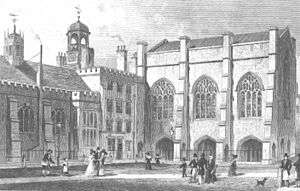Court of equity facts for kids
A court of equity (also called an equity court or chancery court) is a special type of court. It uses principles of fairness and justice instead of strict law to decide cases.
These courts started in England. People would ask the Lord Chancellor for help when regular laws seemed unfair. Equity courts mainly dealt with requests for things other than money, like making someone do what they promised (called specific performance) or issuing special orders.
Over time, most equity courts joined with regular law courts. Now, many courts can handle both common law and equity cases at the same time. Equity courts are known for helping the common law by fixing its problems and making things more fair.
In the early United States, some states had separate courts for law and equity, just like England. Other states, like the U.S. Congress did for federal courts, combined them. For example, U.S. bankruptcy courts are a type of federal equity court.
A few U.S. states, like Delaware, Mississippi, New Jersey, South Carolina, and Tennessee, still keep law and equity separate. In New Jersey, this difference is seen in the different parts of the New Jersey Superior Court.
Contents
How Equity Courts Started
The special way equity courts work comes from their long history. This history shows how ideas of fairness have shaped the law. It also shows how equity's rules and ways of solving problems have changed over time. Social and political changes also affected how these courts worked.
Equity as a Special Kind of Law
Today, equity is seen as a unique part of law. Many modern courts use its principles. The way equity courts developed helped guide how these fair principles are used.
Equity started with different rules from the early Courts of Chancery. Now, courts can use equity while still having the power to fix new kinds of unfairness. Equity isn't a completely separate law. Instead, it works with common law to balance out its strict rules.
The Beginning of Equity's Power
Equity began to appear during three main periods:
- The Middle Ages (1200s–1400s)
- The Shaping Period (1500s–1600s)
- The Systematizing Period (1600s–1800s)
During these times, equity grew. It went from the Chancellor giving fair help based on his own feelings to becoming an organized part of law used by courts.
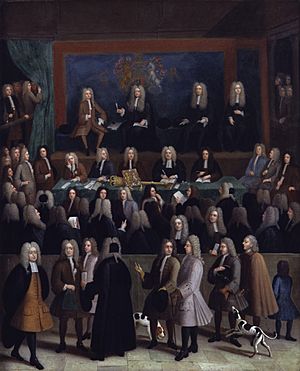
The Middle Ages
The Chancery Division was set up in the 1200s by the King. It was created after the Supreme Court of Judicature was separated. The Chancellor was in charge of the "King's law" in local courts.
At first, the Chancery Division didn't handle actual cases. It mostly did secretarial work for the King. But it still had some judicial power. It could decide if certain legal orders (called writs) were valid. These orders were temporary and could be overturned by regular law courts if they went against the actual law of the land.
As the Chancery grew, the Chancellor became responsible for handling "prayers" and "petitions." These included requests for help or special grants from the King. By the 1300s and 1400s, the Chancery became a large, independent office. Its job was to issue writs for things like inheritance or property transfers. These writs allowed people to start legal claims in the King's courts.
The Shaping Period
In the 1500s, the modern system of equity and the Chancellor's role became more like a court. The courts gained more independence. The Court of Chancery started issuing its own orders, separate from the King's Council. Chancellors became skilled in law and handled petitions in a more organized way.
As the court grew in power, other common law courts became worried. They felt their own power was being threatened. The Court of Chancery had its own special rules and ways of doing things. For example, it could issue a common injunction (a court order to stop something) which was different from what common law courts could do.
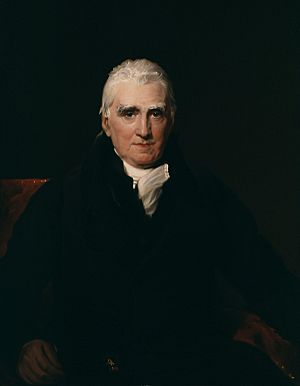
The Systematizing Period
Many people credit Lord Eldon and the Judicature Acts of 1873 with organizing equity. He made the rules and principles of modern equity clearer and more consistent. This helped equity work better with common law.
Before this, the Courts of Chancery had problems in the early 1700s. These included long delays, complicated procedures, high costs, and difficult processes.
The High Court of Chancery
By the early 1500s, most of the court's work was about equity cases. A historian named W.S. Holdsworth believed that equity principles grew through the Chancery. He pointed to three main reasons:
- It helped against the strictness of common law.
- It used ideas about fairness (conscience) to decide rules.
- It had a different way of working than common law. This allowed the Chancellor to decide the fairest path for each case.
Equity and Common Law Working Together
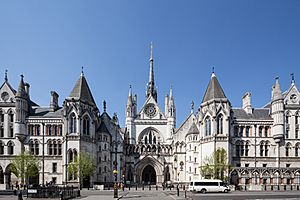
A Combined System
The English Judicature Act of 1873 created new courts: the High Court of Justice and the Court of Appeal. These replaced the old Chancery, Common Pleas, Queen’s Bench, and Exchequer Courts.
After this, different parts of the court could handle both common law and equity cases. As Lord Watson said, the main goal of this Act was to give people in a lawsuit "all remedies to which they are entitled." This meant people didn't have to go to different courts. It also reduced unnecessary legal steps.
How Common Law and Equity Relate
Before the Judicature Acts, equity courts were completely separate from common law courts. You couldn't move a case from one to the other. If you started a case in the wrong court, you had to begin all over again. This was very inefficient and made a big change necessary.
After the Judicature Acts and a famous case called Earl of Oxford’s Case (1615), common law and equity claims could overlap. If there was a conflict between the two, equity would usually win. For example, common injunctions (orders from equity courts) would be upheld.
Exclusive Power
Before the Judicature system, only a Court of Chancery could enforce certain fair claims. Common law courts couldn't. This "exclusive power" gave help against breaches of legal rights that equity didn't cover in other situations. This was allowed because it made sure serious harm was properly paid for. It also stopped many claims about the same issue.
A legal expert named Ashburner described this exclusive power: "The plaintiff's claim was one that, before the Judicature Act, would have given him no right in any court except the Court of Chancery. The Court of Chancery, in giving help, was said to use its exclusive power."
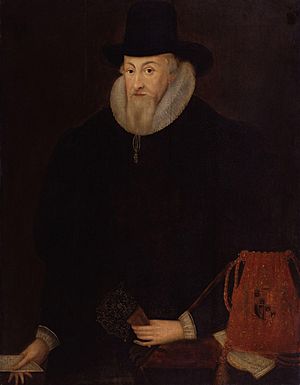
Shared power happens when a case involves both common law and equity actions. The same help can be given by either. After the Judicature system, a person only had to go to one court, not two. This allowed them to enforce both common law and equity principles for a problem.
This shared power lets a person ask for fair help if the help from common law isn't enough to make things right. There is no competition between the two. They can both handle cases as if the other didn't exist. The goal of this shared power is to provide "a more perfect solution or a better way of doing things than the other court could give."
Helping Power
Helping power is when equity assists in legal cases. It helps enforce legal rights even when it doesn't have shared power over the matter. The Court of Chancery didn't step in if enough help was available through common law. Deciding if a claim was legal was left to common law courts. This meant common law was binding on equity.
Helping power simply acted "as a support to justice in other courts." For example, before a trial, the equity court could order documents to be shown. Common law courts couldn't do this. The court's job was to keep things as they were until the parties' rights were decided by common law. After a settlement, it could also help by giving a more effective solution to the person who had already received common law help.
What Equity Courts Are Like
Powers of Equity Courts
Equity courts in England are known for acting in personam. This means they act against a person's conscience, not against a piece of property. However, there are some exceptions to this.
Equity doesn't have strict, formal rules. So, courts must look at people's actions using flexible and fair powers. Courts consider basic principles like good faith, honesty, and integrity. They also look at how fair things are between the people involved. Because the Chancellor has a lot of freedom and many ways to give fair help, courts can also think about the public's interests when deciding a case.
Unlike rulings in the King's or Common Bench, which are binding on a person's rights, equity orders only bind the person to obey. The Chancellor can force a person to face punishment until they obey. An equity order can also be used as a defense in future cases about the same claim. It can show why the Chancellor shouldn't consider it again.
Making Justice Happen
Equity is often seen as being about ethics. Courts often describe it as fair, moral, and just behavior. As Aristotle said, fair conduct helps improve the weaknesses of general law. He believed that equity's role in courts "is to stop the law from sticking too strictly to its own rules when those rules cause unfairness."
Since equity principles are not absolute, courts can move away from rules if they conflict with justice. Unlike legal justice, fair justice develops case by case in courts. This is to make outcomes fairer and to properly judge the needs of specific situations.
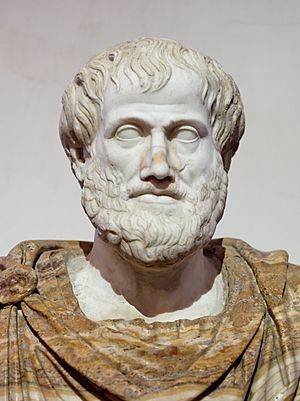
How Equity Courts Compare Around the World
Australia
The Judicature system has been put in place across Australia. South Australia was the first to adopt it in 1853. Acts similar to the Supreme Court of Judicature Act 1873 (in the UK) include:
- Supreme Court Act 1935 (SA)
- Civil Proceedings Act 2011 (Qld)
- Supreme Court Act 1935 (WA)
- Supreme Court Act 1986 (Vic)
- Supreme Court Civil Procedure Act 1932 (Tas)
- Supreme Court Act 1970 (NSW)
- Law Reform (Law and Equity) Act 1972 (NSW)
Even though New South Wales had one Supreme Court of New South Wales with full power in both common law and equity before the Judicature Act, they were still treated as separate courts.
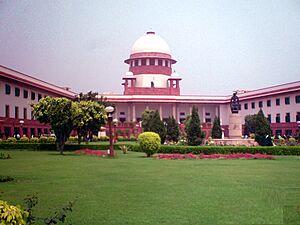
United States
After the American Revolution, many American states like Massachusetts, New York, and Virginia got rid of chancery courts. Equity was not popular then. But in the late 1800s, federal judges brought back the idea of fair injunctions.
Early changes to the U.S. Constitution clearly saw common law and equity as separate parts of law. However, Rule 2 of the Federal Rules of Civil Procedure started in 1938. This rule combined common law and equity claims.
India
Unlike most countries, equity has always worked together with law in India. It was handled by the courts, not against them. After the British wrote down the laws in India, fair principles were included in the court systems.
Courts have used equity "as a source of law to create a new principle when the written law had no answer." The Supreme Court of India recognized this combination of laws. It expanded the use of its fair powers in areas like environmental problems, harm caused by others (tort law), strict responsibility rules, and human rights.
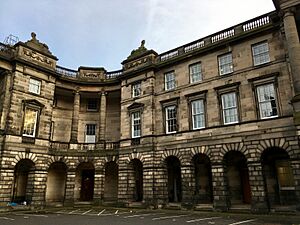
Scotland
Scotland does not have a separate court just for equity. So, its legal system is called "mixed." The Court of Session handles both common law and equity. It tells the difference between them in cases. This gives people more certainty. The court can provide help using either equity or common law, depending on what the person needs.
As the two types of law became harder to tell apart, "what was a rule in equity became in practice considered as common law." Scottish lawyers have worried that this system could lead to unfair decisions. This might happen if cases are approached by combining equity and common law reasoning. Others, like Lord Kames, believed in a dual approach. He thought equity in the court existed to create "new fair rules which slowly became common law because they were used over time."
See also
- Court of Chancery
- Delaware Court of Chancery


